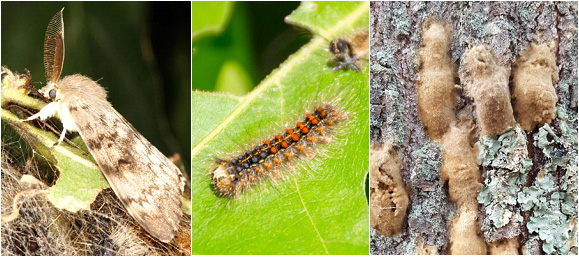Issue 5, June 22, 2022
Spongy Moth: A New Name for an Old Pest

Left: Spongy moth (Lymantria dispar), Gyorgy Csoka, Hungary Forest Research Institute, Bugwood.org
Center: Spongy moth caterpillar, Karla Salp, Washington State Department of Agriculture, Bugwood.org
Right: Spongy moth egg masses, Karla Salp, Washington State Department of Agriculture, Bugwood.org
The pest we formerly knew as gypsy moth is now called spongy moth (Lymantria dispar)!
Why did the name change?
“Spongy moth” replaces the old common name, “gypsy moth,” because it uses a derogatory term for Romani people.
“Spongy moth” also better describes an identifying characteristic of this species: the moth’s sponge-like egg masses. The egg masses are an important target for management efforts of this invasive forest pest.
How was the name “spongy moth” chosen?
The name was selected by a group of more than 50 entomologists and foresters in the United States and Canada, as well as Romani scholars working on human rights issues. Convened by the Entomological Society of America, the group gathered name preferences and comments from a wide audience of interested individuals and organizations.
More than 200 names were evaluated before “spongy moth” was selected. The name comes from the common name used for this insect in France and French-speaking Canada, “spongieuse.”
Why is spongy moth important?
Lymantria dispar is an invasive forest pest that can defoliate hundreds of tree and shrub species. A primary way spongy moth spreads is via egg masses transported on firewood, outdoor equipment, and vehicles. By keeping an eye out for these spongy-looking egg masses, you can play an important role in slowing the spread of this pest.
And, by using its new name, “spongy moth,” you can also help put the old name—and its harmful connotations—in the past.
How might this name change impact pesticide applicators?
Many federal, state and local organizations will be transitioning to the new common name with the goal of completion by March 2023. If you are searching for information about this pest, please keep in mind that you may need to search one or both common names in the coming months.
Spongy moth is currently present in Boone, Cook, DuPage, Kane, Kendall, Lasalle, McHenry, Will and Winnebago counties. These are considered quarantined counties. All nursery stock, property and firewood in affected counties must be inspected and treated for spongy moth before leaving these counties. If you see spongy moth in other Illinois counties, please report it to Illinois Department of Agriculture (866-296-MOTH).
Content from Entomological Society of America’s Spongy Moth Flier lightly edited and expanded upon by Sarah Hughson
Spongy moth flier. 2021. Entomological Society of America. https://entsoc.org/sites/default/files/Spongy-Moth-Flyer.pdf
Lymantria dispar/Spongy Moth (Historically Gypsy Moth) website. 2022. Illinois Department of Agriculture. https://www2.illinois.gov/sites/agr/Insects/Pests/Pages/LymantriaDispar.aspx
Author:
Sarah Hughson